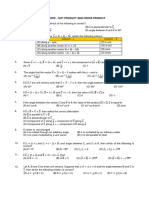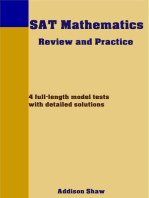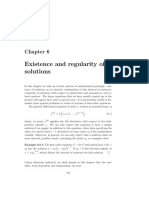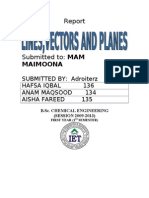CPP - Vector
Uploaded by
madhurikhan1952CPP - Vector
Uploaded by
madhurikhan1952VECTORS – ADDITION AND RESOLUTION
1. Consider two vectors 𝑃⃗ and 𝑄 ⃗ as shown. A point ‘S’ divides the line PQ into
two equal parts (PS = SQ).
⃗ and 𝑆 is
Then the correct relation between 𝑃⃗ , 𝑄
⃗ =𝑆
(A) 𝑃⃗ − 𝑄 ⃗ =𝑆
(B) 𝑃⃗ + 𝑄
⃗ ⃗
(C) 𝑃 − 𝑄 = 2𝑆 ⃗
(D) 2𝑃 − 𝑄 ⃗ =𝑆
2. Resultant of two vectors, 𝐴 and 𝐵 ⃗ is perpendicular to 𝐴 and its magnitude is equal to half of the
magnitude of 𝐵⃗ . Then the angle between 𝐴 and 𝐵⃗ is
(A) 00 (B) 600 (C) 1200 (D) 1500
3. ⃗ +B
Given that A ⃗ and that ⃗C is perpendicular to A
⃗ =C ⃗ . If |A
⃗ | = |C
⃗ |, then what is the angle between A
⃗
⃗
and B
π π 3π
(A) radian (B) radian (C) radian (D) π radian
4 2 4
4. Three vectors as shown in the figure have magnitudes
⃗ | = 4 and |c| = 10.
|a⃗| = 3, |b
⃗ = c, then the values of (p, q)
If c can be represented as pa⃗ + qb
are
5√3 20 20 5√3
(A) ,− (B) − ,
2 3 3 2
1
(C) 1, −1 (D) 1,
2
5. Two vectors P and Q are in ratio P: Q = 1: 2. If their resultant is at an angle tan−1
√3
to vector P, then
2
angle between P and Q is:
1
(A) tan−1 (B) 45° (C) 30° (D) 60°
2
6. Which of the following options represent an unit vector at an angle of 45 0 with the positive x – axis
1 1
(A) î + ĵ (B) î − ĵ (C) (î + ĵ) (D) (î − ĵ)
√2 √2
7. The x and y components of vector 𝐴 are 4m and 6m respectively. The x, y components of vector
𝐴+𝐵 ⃗ are 10m and 9m respectively. Then choose the correct option(s)
⃗ is √45 units
(A) The length of 𝐵
⃗
(B) Angle that 𝐵 makes with the x axis is given by tan−1 2
⃗ is 6 units
(C) The length of 𝐵
1
⃗
(D) Angle that 𝐵 makes with the x axis is given by tan−1
2
8. Given, a⃗ + ⃗b + c + ⃗d = ⃗0. Which of the following statement(s) is (are) wrong?
(A) a⃗, ⃗b, c and d
⃗ must each be a null vector
(B)The magnitude of a⃗ + c equals the magnitude of ⃗b + ⃗d
(C) The magnitude of a⃗ can never be greater than the sum of the magnitudes of ⃗b, c and d ⃗
(D) b + c must lie in the plane of a⃗ and d if a⃗ and d are not collinear and in the line of a⃗ and ⃗d, if they
⃗ ⃗ ⃗
are collinear.
9. The x – component of the resultant of several vectors
(A) is equal to the sum of the x – components of the vectors
(B) may be smaller than the sum of the magnitudes of the vectors
(C) may be greater than the sum of the magnitudes of the vectors
(D) may be equal to the sum of the magnitudes of the vectors
10. ⃗ +B
If A ⃗ =C ⃗ , then choose the correct option(s)
⃗
(A) |C| is always greater than |A⃗| ⃗ | < |A
(B) It is possible to have |C ⃗ | and |C
⃗ | < |B
⃗|
(C) C is always equal to A + B (D) C is never equal to A + B
11. ⃗ +B
A ⃗ =C ⃗ , Vectors A and B if rotated by θ in the same sense to form ⃗⃗⃗ ⃗⃗⃗ , then
A′ and B′
⃗⃗⃗ ⃗⃗⃗
(A) A′ + B′ = C ⃗ ⃗⃗⃗ ⃗⃗⃗
(B) A′ + B′ ≠ C ⃗
⃗ ⃗ ⃗⃗⃗
(C) A. B = A′. B′ ⃗⃗⃗ (D) |A⃗⃗⃗′ + ⃗⃗⃗ ⃗|
B ′ | = |C
12. Choose the correct statements.
(A) Resultant of two unequal vectors cannot be zero
(B) Resultant of three co – planar vectors may or may not be zero
(C) for 2 vectors 𝐴 and 𝐵⃗:𝐴+𝐵 ⃗ =𝐵⃗ +𝐴
⃗ and 𝐶 : 𝐴 + (𝐵
(D) for 3 vectors 𝐴, 𝐵 ⃗ + 𝐶 ) ≠ (𝐴 + 𝐵
⃗)+𝐶
13. Given that A + B + C = 0 . Out of three vectors, the two are equal in magnitude and the magnitude
of third vector is 2 times that of either of the two having equal magnitude. Then find the angles
between vectors.
14. Let A = 2iˆ + ˆj , B = 3 ˆj − kˆ and C = 6iˆ − 2kˆ . Find the value of A − 2B + 3C .
15. Find the vector that must be added to the vector iˆ − 3 ˆj + 2kˆ and 3iˆ + 6 ˆj − 7kˆ so that the
resultant vector is a unit vector along the y-axis.
16. Find the vector sum of N coplanar forces, each of magnitude F, when each force makes an
angle of 2 / N with that preceding it.
17. Two forces of magnitudes P and Q are inclined at an angle (θ). The magnitude of their resultant is
3Q. When the inclination is changed to (180°–θ), the magnitude of the resultant force becomes Q.
Find the ratio of the forces.
18. Two unit vectors are inclined at 600. Find their resultant. Is the resultant a unit vector?
ANSWER KEY
1. C
2. D
3. C
4. B
5. D
6. C
7. AD
8. BCD
9. ABD
10. B
11. B𝐶𝐷
12. ABC
13. 900, 1350, 1350
14. 20𝑖̂ − 5𝑗̂ − 4𝑘̂
15. −4𝑖̂ − 2𝑗̂ + 5𝑘̂
16. 0
𝑃
17. =2
𝑄
18. √3, no
You might also like
- Electrodynamics Tutorials W - (Z-Library) - 1No ratings yetElectrodynamics Tutorials W - (Z-Library) - 1295 pages
- PUA Calars Ectors Class Physics: PART 1: Single Correct QuestionsNo ratings yetPUA Calars Ectors Class Physics: PART 1: Single Correct Questions3 pages
- Sheet Exercise 3 - Vectors - Multi CorrectNo ratings yetSheet Exercise 3 - Vectors - Multi Correct4 pages
- 668bf3f05c5d40b85ba4bf1e - ## - Motion in A Plane - DPPsNo ratings yet668bf3f05c5d40b85ba4bf1e - ## - Motion in A Plane - DPPs26 pages
- Coordinate system and vectors notes + dpps (1)No ratings yetCoordinate system and vectors notes + dpps (1)338 pages
- Module Exercise 2 - Vector (For Section B)No ratings yetModule Exercise 2 - Vector (For Section B)11 pages
- Vectors - DPP 04 (Extra) - Yakeen NEET 3.0 2025No ratings yetVectors - DPP 04 (Extra) - Yakeen NEET 3.0 20253 pages
- Uploads 2024 06 19 JA-Krish - (PH+CH+MT) - V1 2-DanishNo ratings yetUploads 2024 06 19 JA-Krish - (PH+CH+MT) - V1 2-Danish19 pages
- Prov Ak Jee25 Prt3 SRT Booster RevisionNo ratings yetProv Ak Jee25 Prt3 SRT Booster Revision57 pages
- Mathematics 309 - Conic Sections and Their Applications: 1. Solving Quadratic Equations NumericallyNo ratings yetMathematics 309 - Conic Sections and Their Applications: 1. Solving Quadratic Equations Numerically10 pages
- Basic Maths and Calculus - DPP 08 (Of Lec-15) - Yakeen NEET 3.0 2025No ratings yetBasic Maths and Calculus - DPP 08 (Of Lec-15) - Yakeen NEET 3.0 20254 pages
- Sample Solutions To Practice Problems For Exam I: Math 11 Fall 2007 October 17, 2008No ratings yetSample Solutions To Practice Problems For Exam I: Math 11 Fall 2007 October 17, 200827 pages
- Applied Math I Lecture Notes 2 (Chapters 1-5)No ratings yetApplied Math I Lecture Notes 2 (Chapters 1-5)110 pages
- Maimoona: SUBMITTED BY: Adroiterz Hafsa Iqbal 136 Anam Maqsood 134 Aisha Fareed 135No ratings yetMaimoona: SUBMITTED BY: Adroiterz Hafsa Iqbal 136 Anam Maqsood 134 Aisha Fareed 13527 pages
- Soft Computing : Recent Advances and Applications in Engineering and Mathematical Sciences 1st Edition Pradip Debnathinstant download100% (1)Soft Computing : Recent Advances and Applications in Engineering and Mathematical Sciences 1st Edition Pradip Debnathinstant download44 pages
- Catia V5 Bending Torsion Tension Shear TutorialNo ratings yetCatia V5 Bending Torsion Tension Shear Tutorial18 pages
- Functional Analysis 1st Edition Jan Van Neerven - Quickly access the ebook and start reading today100% (1)Functional Analysis 1st Edition Jan Van Neerven - Quickly access the ebook and start reading today66 pages
- Notes On Functional Analysis by Rajendra Bhatia57% (7)Notes On Functional Analysis by Rajendra Bhatia249 pages
- Point-Set Topology With Topics Basic General TopologyNo ratings yetPoint-Set Topology With Topics Basic General Topology822 pages
- Basics of Hermitian Geometry: Vector Spaces Over The Complex Numbers Complex ConjugationNo ratings yetBasics of Hermitian Geometry: Vector Spaces Over The Complex Numbers Complex Conjugation52 pages

























































































